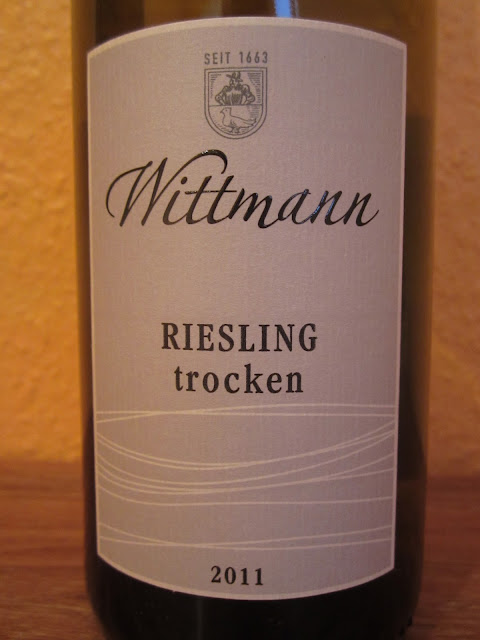The Rheinhessen is the
region just North of the Pfalz and just a 30-minute drive to the base. Since it has similar soil and climate to the Pfalz, the wines are similar in style.
Generally, the Pfalz has a bigger, broader palate and fermented dry. The Rheinhessen is typically not as broad and with a leaner style of elegance. I am not well acquainted with the nuances of Rheinhessen so I asked my cellar master at Koehler-Ruprecht, Johannes, for recommendations. He
recommended Weingut Keller for its consistency and popularity, Weingut Wittmann
for its distinguished mineral intensity, Weingut Gutzler for its Spätburgunder, Thörle for its Silvaner and Weingut Wagner-Stempel for its rich, opulent style.
Map of the 13 different wine regions of Germany
Weingut Keller
Rheinhessen is typically
synonymous with Keller. So Weingut Keller was an obvious recommendation but,
unfortunately, they were all sold out of wine and couldn’t take any tasting appointments
until next spring. Bummer! Apparently, they typically sell out of their Grosses Gewächs wines within 2 weeks. Keller is known for wines that are enormously rich and complex
but not high in alcohol. According to Keller, it is more important to have
precision of the aroma and flavour than sugar levels. Sounds like a great philosophy for great German Riesling. I
can’t wait to try their wines next year!
Weingut Wittmann
Weingut Wittmann is
another well-known winery in Rheinhessen.
They produce pure, deep wines with freshness and elegance and are
regarded as one of the finest Riesling producers in Germany. The winemaker, Philipp Wittmann, was nominated for the 2013 Winemaker of the Year by
Gault Millau, the German wine guide. Pretty high
accolades and deserving of a visit I’d say. Unlike Keller, they did have wines
to taste but, similarly, a majority were sold out. The only Riesling for tasting
was their 2011 Riesling trocken Gutswein. The nose had intense peach aromas with creamy
undertones, and a clean and crisp palate with a fresh lemon finish. We also tasted their 2011 Weissburgunder trocken ‘S’ and 2011 Chardonnay trocken ‘S’, and if the rest of their wines taste as complex and
balanced as the entry level Riesling then I can only imagine and can’t wait to
taste the rest of the range next year.
Weingut Gutzler was recommended
for its Spätburgunder and I have to agree. Until recently, I’ve been having some trouble finding a Spätburgunder that is well balanced and food friendly.
Most have been too light, or too sour, or even too bitter but Gutzler’s Spätburgunders
were terrific! We tasted with the
son and current winemaker, Michael Gutzler. He let us taste their entire range
of wines and informed us that yields are kept down to 25 hectoliters/hectare in order to maintain the highest quality. The care of the vines and soil really pays off,
as you can taste the typicity of their soils and grape variety.
78-year-old vine Silvaner
with hints of melon on the nose and pronounced minerality and salinity on the
palate
100% new oak with no malolactic fermentation gave
this wine developed banana aromas with leesy notes and an appetizing acidity
and freshness
This nose was dense and
complex, with beautiful aromas of white peach. Slightly salty and extremely
mineral on the palate with incredible length
This wine had finesse,
complexity and length with hints of smoke, developed black cheery flavours
and fine tannins that build on the finish
Thörle
It was the Silvaner that
was highly recommended, but it was the Spätburgunder that blew me away! Such a great
tasting, not only did I get more exposure to Silvaner but I tasted a Spätburgunder
that I really enjoy!
A very distinctive nose of fresh herbs and notes of obvious fruit ripeness. It was spicy and well concentrated on the palate, with light herbs returning on the long finish. It lacked acidity because of malolactic fermentation, but the wine is complex, vibrant and still young.
A brilliant nose with ripe and succulent fruit aromas, very vibrant and mineral on the palate with a warm finish
The Riesling had a deep, cool
mineral nose with ripe fruit flavours. It was smoother on the palate, lacking
its cool, delicate raciness implicated by the nose. The Silvaner had
concentrated minerality with subtle fruit aromas and a fine acidity. Sufficiently
soft on the palate makes it a perfect pairing with the delicate flavours of
seafood and white meat
Made from the best grapes
of Hölle vineyard. Hölle means
‘hell‘ in German and was given this name because it’s the hottest vineyard in
the region. The wine had a nose of ripe black cherry with the freshness of ripe
strawberries on the palate, great medium body with balanced acid and a long
finish
Weingut Wagner-Stempel
Since Weingut Wagner-Stempel is located in the most southern part of the Rheinhessen and closest to the Pfalz, I am not surprised to hear of its rich, opulent style, which sounds reminiscent to the Pfalz. Unfortunately, I was unable to taste the wines because on the day I visited Rheinhessen the winery was closed for his son's birthday. But I'll keep you posted as I plan to taste their wines next week.




































